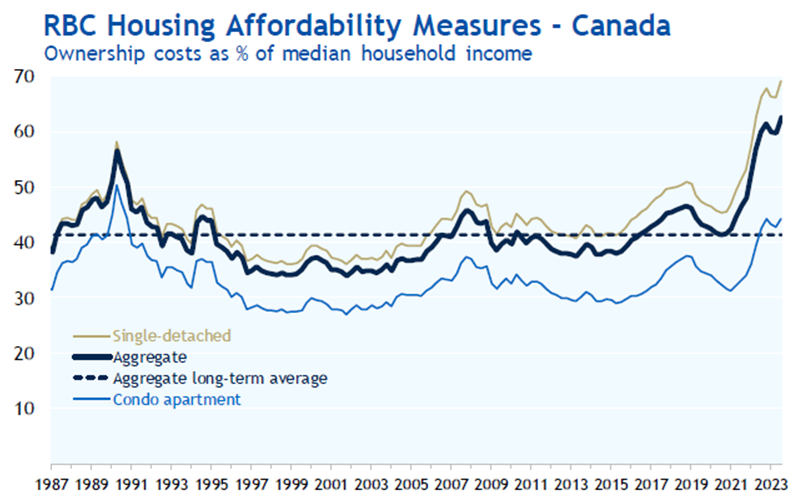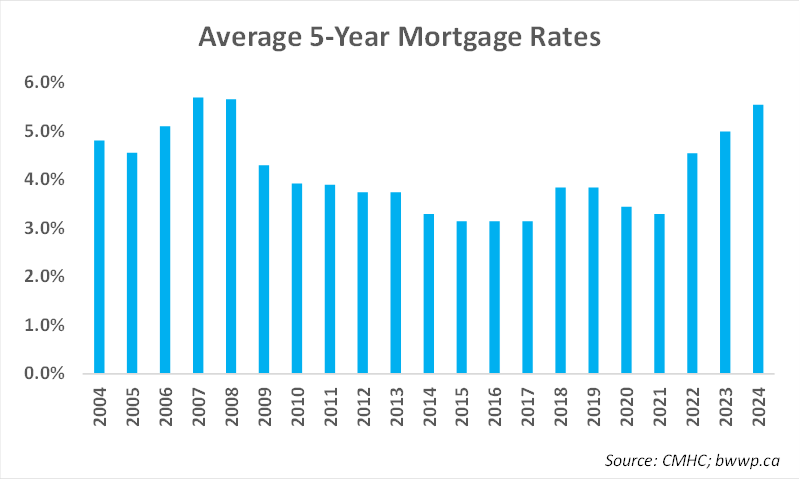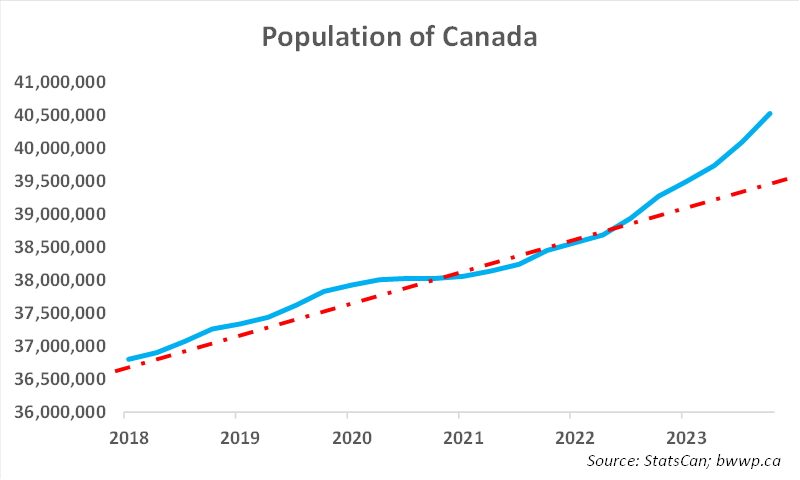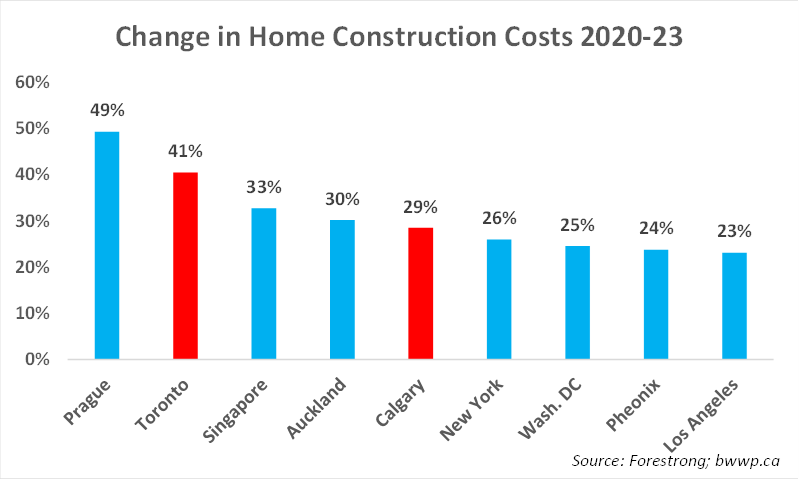We thought we would begin 2024 with our thoughts on the Canadian housing markets. We had contemplated doing a piece on U.S. politics with Monday’s Republican Iowa caucuses set to kick-off the 10-month sprint to Election Day, but then we started thinking about the slate of candidates and the complete and utter stupidity that is going to spring mainly from one side and a bit from the other side and we decided that there were better ways to start off a year that is going to be so great that we added an extra day so we could enjoy 0.27% more of it than each of the prior 3-years.
With that said – you might be able to tell from our title that we have a rather unique view (apologies for adding a qualifier to “unique”, which is a grammatical faux pas, but we like the literary flair) of where Canadian housing is heading, so let’s get into it with a chart:
 Here we are looking at RBC Economics’ affordability index, which shows all forms of Canadian housing at the least affordable levels going back 35-years. The index now sits at 62.5%, which means that the average household would need to spend 62.5% of its income to cover the ownership costs of the average home in Canada. The situation is much worse in Toronto (84.1%) and Vancouver (102.1%), but nationwide, we are about 50% above the long-term average (the dotted line), which sits closer to 40%.
Here we are looking at RBC Economics’ affordability index, which shows all forms of Canadian housing at the least affordable levels going back 35-years. The index now sits at 62.5%, which means that the average household would need to spend 62.5% of its income to cover the ownership costs of the average home in Canada. The situation is much worse in Toronto (84.1%) and Vancouver (102.1%), but nationwide, we are about 50% above the long-term average (the dotted line), which sits closer to 40%.
Condos do not look as bad, but even then, the average household would need to spend more on the average condo than the long-term average for the average home (which skews higher because of the significantly higher cost of single-family detached homes). Other than prices, which remain elevated despite some weakness in 2023, the big driver of the deterioration in affordability remains mortgage rates:
 Mortgage rates remain 2-3% above where they were in 2021, which adds about $1,200 of interest costs per month to a $500k mortgage. Considering that is paid out of after-tax income, the average Canadian household would need an additional ~$25k of annual income to cover the increase. Add to this that fact that the cost of everything else has also skyrocketed and it’s not surprising that we get the following:
Mortgage rates remain 2-3% above where they were in 2021, which adds about $1,200 of interest costs per month to a $500k mortgage. Considering that is paid out of after-tax income, the average Canadian household would need an additional ~$25k of annual income to cover the increase. Add to this that fact that the cost of everything else has also skyrocketed and it’s not surprising that we get the following:
 Only about 25% of households in Canada can currently afford a single-family abode; although, these percentage are significantly skewed by Ontario and especially BC. Condos look a bit better (closer to 45%), but the current situation has no doubt weighed on demand and is likely to continue to do so in the first half of 2024.
Only about 25% of households in Canada can currently afford a single-family abode; although, these percentage are significantly skewed by Ontario and especially BC. Condos look a bit better (closer to 45%), but the current situation has no doubt weighed on demand and is likely to continue to do so in the first half of 2024.
“Pent’ing” Up Demand
Based on the above, we would not be surprised to see some further weakness in 2024. While affordability will improve as mortgage rates come down, the banks are reluctant lenders at present (the state of the economy is “meh”, which tends to lead to a more defensive lending posture) and unless prices drop significantly (we see some weakness, but doubt it will be much), the rate relief is unlikely to be enough to push affordability more than a few percentage points.
But, there is an offshoot to this, which is leading us toward our “future bubble” thesis – Canada is creating a lot of new households. Let’s pivot to another chart before continuing:
 Canada’s population has exploded over the past 5-years. As we have noted in past missives, this has been key to keeping the economy growing as overall GDP has remained on a positive trendline, despite a decade-long decline in GDP per capita. Of course, all these new Canadians need some place to live and if they are not buying for the reasons outlined above, well then, they are renting, which has helped to contribute to this:
Canada’s population has exploded over the past 5-years. As we have noted in past missives, this has been key to keeping the economy growing as overall GDP has remained on a positive trendline, despite a decade-long decline in GDP per capita. Of course, all these new Canadians need some place to live and if they are not buying for the reasons outlined above, well then, they are renting, which has helped to contribute to this:

There were ~1.2 million more Canadians in October of 2023 than there were in October of 2022. At some point, many of these new Canadians, coupled with existing Canadians who otherwise would have been home buyers over the past two going on three years, are going to be potential home buyers. This demand is building up and is likely to continue to do so in 2024 as the population continues to grow and the groundswell of future demand keeps on backing up. We created our own measure, which provides a gauge of this pent-up demand:
 The Sales-to-Population ratio or SOP looks at annualized existing home sales in Canada and compares them to the population. Over the past 17-years, Canada has averaged ~14,000 home sales per million people. That figure currently sits closer to 10,000 per million, which means that there are ~160,000 homes on an annualized basis that are not changing hands because of poor affordability. We did have a big surge in this metric post COVID, but this was after several years below average, and keep in mind – new Canadians, and there are an awful lot of them, are unaffected by what took place during the COVID boom years. In other words, they are would-be home buyers regardless of what took place before they got here.
The Sales-to-Population ratio or SOP looks at annualized existing home sales in Canada and compares them to the population. Over the past 17-years, Canada has averaged ~14,000 home sales per million people. That figure currently sits closer to 10,000 per million, which means that there are ~160,000 homes on an annualized basis that are not changing hands because of poor affordability. We did have a big surge in this metric post COVID, but this was after several years below average, and keep in mind – new Canadians, and there are an awful lot of them, are unaffected by what took place during the COVID boom years. In other words, they are would-be home buyers regardless of what took place before they got here.
As each month goes by and the SOP remains well below average, we are simply building more and more of a future backlog. Imagine a hose in which the water is turned on high, but there is a kink halfway along the hose. The water is going to gradually build up until either the water is turned off (not really an option), the kink is removed (lower rates, easier credit, and better affordability in our analogy) or the hose breaks. As to the final part of our hose analogy – the hose breaks – while we have trouble picturing what this would be, we would add that one potential salve would be a government-led initiative to build lots of new homes that would help to balance better the coming demand surge. The problem with that is this:
 While new supply would help, given the sharp rise in construction costs, this is hardly going to provide much relief, as costs of doing so are likely to be high and reflected in home prices. The government for its part did recently announce a new “Wartime Home Strategy”, which aims both to lower the cost of building new homes and speed up the building process through a post-WWII stratagem that looks to lean on pre-approved architectural designs for various types of housing. While this worked well coming out of WWII, we are skeptical that it will have any meaningful impact in the current environment as building pre-fab homes in vast open spaces in which lot sizes can be made the same is drastically different than trying to build multi-family units in cities in which parcels of land vary from site to site.
While new supply would help, given the sharp rise in construction costs, this is hardly going to provide much relief, as costs of doing so are likely to be high and reflected in home prices. The government for its part did recently announce a new “Wartime Home Strategy”, which aims both to lower the cost of building new homes and speed up the building process through a post-WWII stratagem that looks to lean on pre-approved architectural designs for various types of housing. While this worked well coming out of WWII, we are skeptical that it will have any meaningful impact in the current environment as building pre-fab homes in vast open spaces in which lot sizes can be made the same is drastically different than trying to build multi-family units in cities in which parcels of land vary from site to site.
Final Thoughts
Tying this all together, our view is:
- We are likely to see some weakness in housing prices in 2024; although, we expect losses to be muted.
- As mortgage rates begin to come down, which we suspect will be the case in Q3 and Q4 of this year, and with the continued build-up of demand, we think the potential for a sharp upward move in home prices in 2025 and beyond is high. We concede that we may be wrong on the timing, but our confidence is high that a housing bubble in the next one to three years is a high risk.
- Would-be home buyers should consider at least kicking the tires on houses now as opposed to waiting for mortgage rates to come down. Most banks offer “homeline plans”, which allow for multiple mortgage tranches as opposed to locking in one rate for one set term. In this way, a would-be buyer could take say a 1-year, 3-year and 5-year tranche and if rates do come down, the would-be buyer would have the opportunity to lock in part of the mortgage at more favorable rates when the 1- and 3-year tranches mature.
